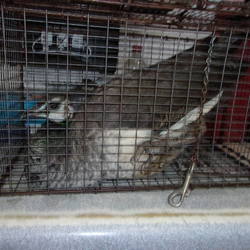

Humane Society Silicon Valley became the first shelter to achieve “model” status just last September.

Now, there’s even an Association of Shelter Veterinarians, which released model shelter standards in 2010. It’s no coincidence that in 1998, the first-ever formal shelter medicine class was held at Cornell University, heralding a new understanding of what keeps shelter animals physically and mentally healthy. They’ve recognized their capacities, not only to provide housing and care, but to save lives. In the years since, though, shelters have gotten far more ambitious. If a few got lucky and got adopted out, that was awesome, but for most of these animals, the shelter really was the last stop, and the best I could do was keep them as comfortable as possible until that very last breath.” It was the early ’90s, and back then, “we weren’t focused on how we could do anything differently. Like many in the sheltering world, she recalls her first job in the field at “a little tiny facility with six dog kennels and a garden shed for cats at a wastewater treatment plant.” “Most of the time, the best we could offer most of our shelter animals was this quote-unquote ‘stress-free, humane death,’” says Kirsten Vantwoud, COO at the Humane Society of Indianapolis (IndyHumane). Illustration by Aleks Sennwald From fatalistic to fired up It was time for another movement-one that spawned innovative, dynamic shelters that embrace the people in their communities, so far from pounds you wouldn’t even call them the same breed. In the public vernacular, “pound” and “dogcatcher” became commonly used slurs, equating shelters’ and animal control officers’ work with a time when pounds were where animals went to die and dogcatchers were sinister. Within 60 years, however, pet homelessness spiraled out of control-an estimated 15-20 million shelter dogs and cats were losing their lives each year. Public perception of dogs and cats evolved from animals to cherished companions, and the role of shelters and animal control officers evolved along with it. By 1907, every state had some form of anti-cruelty statute. The abolition was reflective of an overall movement: Inspired by the Royal Society for the Prevention of Cruelty to Animals (RSPCA) in the U.K., the ASPCA formed in New York City in 1866 three years later, the Women’s Humane Society opened a shelter in Philadelphia and hired its own animal control officers. or Miss So and So has been knocked in the breast and has had her pet dog taken away from her by force,” said the society’s then-president to a local journalist.


“You will not read any more complaints in the newspapers that Mrs. Thankfully, New York City abolished pounds and dogcatchers in 1894 after the ASPCA agreed to care for strays. On a bad day in 1887, around 700 dogs were drowned in the East River. The moneymaking potential gave rise to “dogcatchers,” who were known to falsely accuse people of flouting ordinances and sometimes stole dogs right out of their owners’ arms. The word became something more ominous in the 19th century, when rabies panic led the New York City health department to offer a reward for every stray or rulebreaking dog brought to the “pound,” where they could be reclaimed for a fine or killed. Still standing in parts of England and the U.S., these modest holding spots were known as “pinfolds” or “pounds.” In the 18th century, towns held wandering farm animals in stone enclosures until they could be reclaimed for a fine or sold at the local market. Not your mother’s animal shelter After decades of innovation, sheltering has progressed far beyond its ‘dog pound’ rootsĪnimal Sheltering magazine Spring 2018 Illustration by Aleks Sennwald


 0 kommentar(er)
0 kommentar(er)
